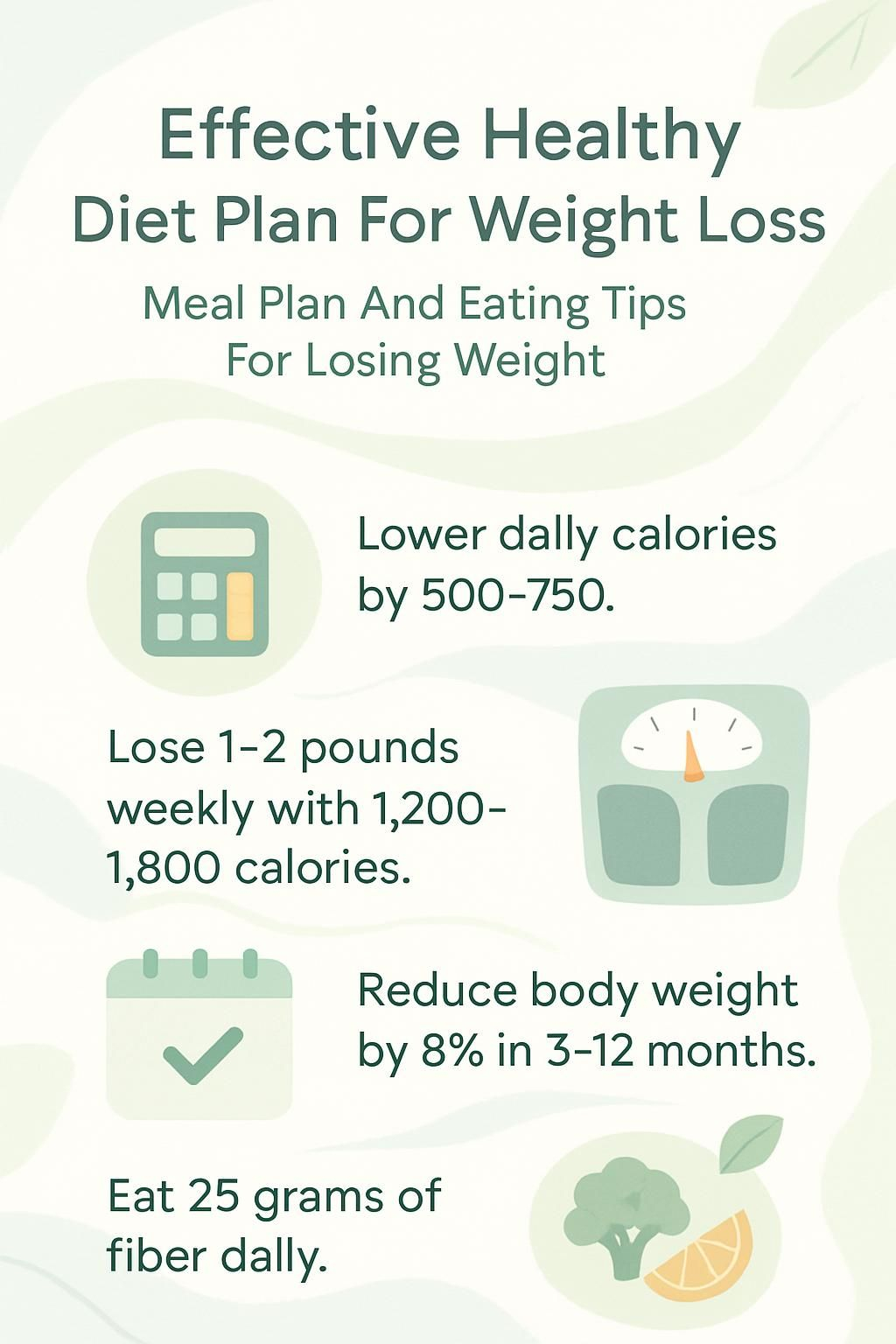Effective Healthy Diet Plan For Weight Loss: Meal Plan And Eating Tips For Losing Weight
Our Nutrition Assistant AI Suite will transform your body. You will lose fat, get toned, and build muscle. Gain confidence and optimal health.
Finding a healthy diet plan for weight loss can feel hard, especially with a busy schedule. I have been there too. Research from Mayo Clinic shows that building steady habits supports healthy weight loss and better weight management. In this article, I share a simple meal plan, clear eating tips, and strategies that fit real life while keeping favorite foods in the mix.
If you want practical steps and real results, you are in the right place.
Key Takeaways
- A daily calorie deficit of 500 to 750 calories, about 1,200 to 1,500 calories for most women and 1,500 to 1,800 for men and active adults, supports losing 1 to 2 pounds per week.
- The Mayo Clinic Diet and the Mediterranean diet focus on high-fiber foods like fruits, vegetables, whole grains, lean proteins, and healthy fats such as olive oil to support sustainable weight loss.
- Intermittent fasting can reduce body weight by up to 8 percent in three to twelve months, based on a 2019 research summary.
- Aim for at least 25 grams of dietary fiber daily. Higher fiber improves digestion and lowers the risk of type 2 diabetes and high blood pressure.
- Meal planning with portion control, such as using food journals or smaller plates, raises long-term success rates according to Mayo Clinic and CDC guidance from 2022 to 2024.

Key Elements of a Healthy Weight Loss Diet Plan

A strong plan starts with smart food choices and simple habits. I focus on steps that fit daily life and support long-term progress.
How Do You Create a Calorie Deficit?
I create a calorie deficit by eating slightly fewer calories and moving more. Experts suggest cutting 500 to 750 calories per day to lose about 1 to 2 pounds weekly.
For most women, that is about 1,200 to 1,500 calories per day. Men and active adults often do well between 1,500 and 1,800 calories. This range helps you lose excess weight while still getting important nutrients.
I choose nutrient-dense foods that are lower in calories and higher in vitamins and minerals. This keeps me full and supports health. Very low calorie diets under 800 calories should be medically supervised due to safety risks.
Balancing carbohydrates, protein, and fat helps me keep a steady pace without feeling deprived.
What Is the Right Balance of Proteins, Fats, and Carbohydrates?
The best mix depends on your health and goals. For weight loss and heart health, I aim for 45 to 55 percent carbs from whole grains, vegetables, fruits, and beans, 15 to 25 percent protein from lean sources like fish or cottage cheese, and 20 to 35 percent healthy fats from nuts, seeds, and olive oil.
The Mayo Clinic Healthy Weight Pyramid encourages plenty of non-starchy vegetables and fruits because they are filling and low in calories. I swapped white bread for whole grain bread at lunch and saw fewer blood sugar spikes. I use olive oil instead of butter to boost heart-friendly fatty acids.
Adding yogurt at breakfast increases protein, which helps curb mid-morning hunger. Studies link this balanced approach to lower risk for type 2 diabetes, high blood pressure, obesity, and cardiovascular disease.
How Can Portion Control Help With Weight Loss?
Portion control helps me lower calorie intake without losing balance. Guidance from the U.S. Department of Health and Human Services shows that smaller portions support a healthy diet plan.
I use a food journal or app to track servings of grains, dairy, proteins, and desserts. Smaller plates make reasonable portions look satisfying. One cup of raw vegetables instead of two still gives me fiber and nutrients with fewer calories.
Research links consistent portion control to healthier eating habits and lower risk for conditions tied to overweight and obesity.
Principles for a Successful Weight Loss Diet
Clear, evidence-based principles make healthy eating easier to follow. I use these to guide everyday choices.
Why Choose Whole, Unprocessed Foods?
Whole foods tend to have more nutrients and fiber with fewer added sugars and unhealthy fats. I lean on whole grains like quinoa and oats, fruits and vegetables, beans, nuts, and fish.
People who base meals on plants have lower risks of heart disease, hypertension, type 2 diabetes, certain cancers, and stroke. Extra fiber keeps me full longer, which helps me eat fewer calories.
I limit foods high in trans fat and saturated fat to support weight and blood sugar control. For example, I pick baked sweet potato instead of fries or hummus with cucumber slices for a snack.
How Do High-Fiber Foods Aid Weight Loss?
High-fiber foods help me stay full longer, so I eat fewer calories. Fruits, vegetables, and whole grains offer fiber with fewer calories per bite.
The Mayo Clinic Diet supports generous portions of these foods because they add bulk without adding much fat or cholesterol. Reviews show that high-fiber diets support weight control better than low-fiber plans.
Fiber also supports digestion and regular bowel movements. Some people notice temporary gas when increasing fiber. That usually improves within a few days.
I add leafy greens, almonds, seeds, nonfat yogurt with fruit, and legumes. These choices reduce the need for processed snacks with added sugars and unhealthy fats.
How Can You Reduce Added Sugars and Saturated Fats?
I swap mayonnaise, cream, and heavy sauces for low-fat or fat-free options. The American Heart Association suggests keeping saturated fat under 10 percent of daily calories to lower coronary artery disease risk.
I cook with olive oil instead of butter. Lean proteins such as skinless chicken or eggs keep me satisfied without excess saturated fat.
To cut added sugars, I avoid sugary drinks and limit desserts. I reach for whole fruit instead. A CDC report from 2022 estimated Americans average about 17 teaspoons of added sugar daily. Many guidelines suggest no more than 6 to 9 teaspoons per day.
These swaps support steady weight loss and better health.
Why Is Staying Hydrated Important for Losing Weight?
Water supports metabolism and helps the body burn calories. The Mayo Clinic Diet highlights hydration as a daily habit for people who want to manage their weight.
When I drink water before meals, I feel less hungry. In one study, adults who drank two cups of water before meals lost 44 percent more weight in twelve weeks than those who did not¹.
Thirst can feel like hunger. Keeping a refillable bottle nearby helps me avoid extra snacking and keeps a very low calorie plan safer by reducing appetite swings.
¹Davy BM et al., Obesity (Silver Spring), 2010 May;18(5):1101-6
Effective Meal Planning Strategies
Planning meals helps me control calories and pick nutritious foods. A simple plan saves time and reduces stress during the week.
How Should You Schedule Your Meals in Advance?
Setting meal times makes it easier to stick to your eating plan. It also reduces cravings and keeps energy steady.
- I set fixed times for breakfast, lunch, and dinner. This rhythm prevents skipped meals and overeating later.
- I use the Mayo Clinic Diet food and exercise journals to plan meals, track calories, and meet calorie restriction targets.
- Once a week, I write a simple menu that includes vegetables or fruit at every meal.
- I prep soup or salad the night before, which makes busy days easier.
- I portion snacks in small containers. Pre-cut veggies or nuts help me avoid chips or other diet food with extra salt.
- I include protein such as eggs to stay full between meals and support physical fitness goals.
- I time meals around exercise. A balanced snack after activity supports recovery without fast food.
- I follow the LIVE IT! phase idea from the Mayo Clinic Diet to make these routines part of daily life.
- I schedule water breaks to support digestion and heart health and to avoid mistaking thirst for hunger.
- I keep meal timing consistent to support better sleep, which helps appetite hormones stay balanced.
What Is the Best Way to Include a Mix of Food Groups?
I use the Mayo Clinic Healthy Weight Pyramid. I fill half my plate with vegetables and fruits, add lean protein like beans or fish, choose whole grains such as brown rice or pasta, and include healthy fats from nuts and olive oil.
The Mediterranean diet also encourages variety across food groups. Health guidance in England supports this approach to cover vitamins and minerals your body needs.
People with diabetes may find it helpful to pair fiber-rich vegetables with protein for steadier blood sugar. On weekends, I plan meals so each dish includes at least two food groups.
Why Is It Important to Avoid Missing Meals?
Skipping meals makes it harder to meet your nutrition needs for the day. It can also lead to low energy and stronger cravings later.
Research shows that missing meals may slow metabolism and increase the chance of overeating high-calorie snacks. I get better results by eating fewer calories through portion control rather than by skipping meals.
Regular meals stabilize blood sugar and reduce hunger swings. Reviews show better long-term weight outcomes for people who avoid skipping meals.
How Can You Prepare Nutritious Snacks?
Well planned snacks keep me satisfied between meals and support weight loss. I choose options rich in fiber, protein, and healthy fats.
- Grab 1 cup of sliced bell peppers or an orange for vitamins and fullness.
- Pick a small nut mix for fiber and healthy fats that fit a low-fat diet plan.
- Choose Greek yogurt with berries to combine protein and antioxidants.
- Keep a banana handy. Many 1,200 calorie Mediterranean menus include it as a snack.
- Limit dessert-style snacks to 75 calories per day in a Mediterranean-style plan.
- Pair vegetable sticks with hummus to avoid added sugars and saturated fats.
- Drink water with your snack to support appetite control.
- Make energy bites with oats, seeds, and dried fruit for slow-release energy.
- Pre-portion snacks, so stress or hunger does not lead to overeating.
Balanced, nutrient-dense snacks support lower disease risk and better weight control.
Sample 7-Day Meal Plan for Weight Loss
This 7-day meal plan offers balanced menus that support calorie control. It includes ideas from the Mediterranean diet, intermittent fasting windows, and plant-forward choices.
What Should You Eat for Breakfast, Lunch, and Dinner on Day 1?
Breakfast: 3/4 cup bran flakes with one sliced banana and one cup fat-free milk. High fiber helps create a calorie deficit while keeping you full.
Lunch: Mini whole wheat pita with 3 ounces turkey breast, half a roasted pepper, one teaspoon mayonnaise, mustard, and lettuce. Add a mozzarella string cheese and two kiwis for vitamins and fiber. I sometimes use a veggie niçoise pita at about 290 calories.
Dinner: Four ounces flounder using a Zesty Lemon-Herb approach, plus one cup couscous and one cup broccoli. I enjoy a single-serve ice cream to meet a sweet craving without excess added sugar or saturated fat.
What Are Healthy Meal Ideas for Day 2?
Breakfast: Smoothie with one cup frozen berries, half a banana, and eight ounces low-fat or fat-free milk. I add one or two hard-boiled eggs to boost protein and stay full longer.
Lunch: One cup vegetable soup with a veggie burger on whole grain toast or an English muffin. Sometimes I choose a mushroom-quinoa burger for extra fiber. One cup grapes adds a sweet side supported in Mediterranean diet research for weight control1.
Dinner: Four ounces chicken cutlets with barbecue sauce, plus two cups sautéed spinach in olive oil with garlic for heart-friendly fats2. I add sliced tomato or potato for variety without many calories3.
1) “Mediterranean Diet Can Help With Weight Management,” systematic review and meta-analysis, 2020. 2) Meta-analysis, 2019, association between olive oil and lower risk of certain diseases. 3) CDC Health Information, Portion Size and Nutrition, 2024 update.
What Are Balanced Meals for Day 3?
Breakfast: 1/2 cup oats with low-fat or unsweetened soy milk, half an apple, one teaspoon honey, and cinnamon. It offers fiber and protein with gentle sweetness.
Lunch: Chicken salad with 4 ounces roast chicken, grapes, almonds, and celery. I mix one tablespoon mayo and one tablespoon yogurt for a lighter dressing. I serve it over lettuce with multigrain toast for slow-digesting carbs.
Dinner: Four ounces steamed shrimp with a baked potato topped with three tablespoons salsa and one tablespoon Greek yogurt. I add steamed spinach for iron and calcium. Dessert is either one ounce chocolate or a 100 to 150 calorie ice cream bar.
What Should You Include in Your Meals on Day 4?
Breakfast: One cup plain or low-sugar Greek yogurt with one cup berries. The protein helps me feel full, and berries add fiber and vitamins.
Lunch: Mushroom quesadillas in about 25 minutes. I add cucumber spears, then half a cup cottage cheese or another serving of Greek yogurt with two clementines for vitamin C and calcium.
Dinner: Pork tenderloin with balsamic vinegar, honey, and thyme, plus roasted butternut squash at about 370 calories per serving. Reviews through June 2024 support meals rich in lean protein and fiber for weight management.
In my experience, consistent meal structure helps weight loss and may reduce long-term disease risk, even before considering weight-loss surgery.
What Are Good Meal Choices for Day 5?
Breakfast: One whole-grain waffle with two tablespoons nut butter and a small banana. I add cinnamon and nutmeg for flavor and drink eight ounces fat-free milk.
Lunch: Tuna salad made with low-fat mayo and nonfat yogurt at about 135 calories per serving. Ten baby carrots for crunch and two-thirds cup Greek yogurt for extra protein. A small pear for natural sweetness.
Dinner: Spicy sausage jambalaya with three cups spinach sautéed in garlic and one tablespoon olive oil. Reviews published before June 2024 suggest frequent leafy greens support better health and lower chronic disease risk.
What Should You Eat on Day 6 for Weight Loss?
Breakfast: Half an English muffin with one ounce reduced-fat cheese, tomato slices, fresh spinach, and one poached egg. I add a grapefruit for vitamin C and fiber.
Lunch: Black bean salad with 1/2 cup black beans, 1/2 cup orange slices, bell pepper, onions, and other vegetables. I drizzle vinegar and serve over leafy greens. A corn tortilla and a piece of fruit round out the meal.
Following this pattern helps my health since a strong diet lowers the risk of conditions linked to obesity.
What Does a Healthy Day 7 Meal Plan Look Like?
Breakfast: Plain Greek yogurt with sliced strawberries and one tablespoon chia seeds for protein and fiber. Mid-morning, I snack on carrot sticks with two tablespoons hummus.
Lunch: Grilled chicken salad with cherry tomatoes, cucumbers, a drizzle of olive oil, and half an avocado for healthy fats. Afternoon snack: An apple with ten almonds.
Dinner: Baked cod with herbs, roasted sweet potatoes, and steamed broccoli. I keep the day around 1,400 calories to maintain a calorie deficit, as many experts suggest^1^.
This pattern helps me manage weight and reduce chronic disease risk while keeping energy steady.
^1^ See resources in credible nutrition databases such as USDA FoodData Central or consult expert-based sample plans available through registered dietitian associations for exact values suited to individual needs.
Popular Dieting Techniques for Weight Loss
Several eating styles can help people lose weight and improve their health. Here are a few that I use with simple meal planning.
What Is the Mediterranean Diet and How Does It Help?
The Mediterranean diet features fruits, vegetables, whole grains, fish, beans, and healthy fats like olive oil. I often follow a 1,200 calorie sample day: overnight oats with berries and a pear, Tuscan white bean soup with a pesto drizzle, and sheet-pan roast chicken with broccolini, onion, and tomatoes, with produce-forward snacks.
Research links this eating style to better heart health, improved blood sugar control, and helpful weight loss because fiber-rich foods keep you full. Nutrient-dense choices also provide the vitamins and minerals your body needs when you are losing weight.
How Does Intermittent Fasting Support Weight Loss?
Intermittent fasting limits the hours for eating each day or week. A shorter eating window can lower insulin levels and help the body use fat stores for energy.
A 2019 review reported up to 8 percent body weight loss over three to twelve months. I plan meals within the eating window and choose filling foods. This reduces snacking on processed items and supports healthy habits.
What Are Plant-Based Diets and Their Benefits?
Plant-based diets center meals on vegetables, fruits, beans, lentils, whole grains, nuts, and seeds. The Mayo Clinic Diet allows generous servings of non-starchy vegetables and most fruits, which makes this style easier to follow.
Shifting from animal products lowers saturated fat and can improve cholesterol over time. People who follow a vegetarian diet often have lower body weight, and some data suggests lower rates of heart disease and certain cancers¹.
¹ Harvard T.H. Chan School of Public Health: https://www.hsph.harvard.edu/nutritionsource/healthy-weight/diet-reviews/vegetarian-diet/#health-benefits.
How Effective Are Low-Carb Diets for Losing Weight?
Many people do well with low-carb diets that emphasize vegetables, lean protein, and healthy fats while cutting added sugars and refined grains.
A 2020 meta-analysis in the British Medical Journal found low-carb plans produced about 2.6 pounds more weight loss than moderate or higher carb plans over six months. In the DIETFITS study from Stanford, lower carb intake led to greater waist reductions and improved blood sugar control.
I focus on leafy greens, eggs, fish, chicken breast, nuts, seeds, avocados, and olive oil. This leaves me full longer without counting every calorie and keeps energy steady for daily tasks and workouts.
Benefits of a Balanced Diet for Weight Management
A balanced diet supports steady weight loss and better health. Variety keeps meals interesting and makes the plan easier to maintain.
How Does a Balanced Diet Promote Sustainable Weight Loss?
A balanced diet helps me lose weight at a safe pace, about 1 to 2 pounds per week in the Mayo Clinic Diet LIVE IT! phase. Plenty of vegetables, lean proteins, and whole grains make meals filling without going over my calorie target.
During the LOSE IT! phase, I saw quick early progress, about 6 to 10 pounds in two weeks. That boost helped me stay focused. Variety across food groups also reduces cravings and supports long-term success.
In What Ways Does It Boost Energy Levels?
Fruits, vegetables, whole grains, and healthy fats provide steady fuel. These foods bring fiber, B vitamins, and complex carbohydrates, which help prevent energy spikes and crashes.
Studies from Harvard T.H. Chan School of Public Health suggest that diets rich in these foods stabilize blood sugar. After I added more plant foods and cut processed snacks, my afternoon energy improved. Whole grains release energy slowly, and healthy fats from nuts and olive oil support focus.
How Can It Lower the Risk of Chronic Diseases?
Losing 5 to 10 percent of body weight can lower blood pressure, cholesterol, and blood sugar. I have seen personal gains by choosing meals with fewer added sugars and more vegetables, fruits, lean proteins, and healthy fats.
Doctors report fewer cases of type 2 diabetes, heart disease, sleep apnea, and high blood pressure when patients follow this approach. Building meals around brown rice or oats and limiting processed snacks helped me regulate appetite and energy.
Why Is a Balanced Diet Good for Digestive Health?
High-fiber meals help food move smoothly through the digestive system. I notice fewer stomach issues when I eat more whole grains, fruits, and vegetables.
Consuming 25 to 35 grams of fiber daily supports regular bowel movements and a healthy gut. Lean proteins from beans, fish, or low-fat dairy aid tissue repair. Reducing added sugars and saturated fats may ease gut inflammation. Drinking enough water softens stool and helps digestion.
Practical Dietary Tips to Support Weight Loss
Small daily actions can strengthen any eating plan. These tips are easy to start and help build healthy eating habits.
What Is Mindful Eating and How Can It Help?
Mindful eating means paying attention to your food and the act of eating. I slow down, notice flavors and textures, and check my hunger level before and during meals. The Mayo Clinic Diet encourages this approach to break habits like eating in front of a screen.
Studies show mindful eating reduces binge eating and supports weight loss by building awareness. Simple steps, like sitting at a table and putting the fork down between bites, help me follow reasonable portions.
How Do You Manage Portion Sizes Effectively?
I use a digital food journal to track what and how much I eat. The Mayo Clinic Diet and other plans emphasize portion control as a core skill.
Smaller plates and bowls lead to smaller portions. People often underestimate calories by up to 20 percent. Pre-measuring snacks into small containers keeps servings in check and supports daily goals without feeling restricted.
Why Should You Limit Late-Night Snacking?
Late-night snacks can add extra calories and make it harder to lose weight. Eating late can also raise morning blood sugar and disrupt sleep.
When I stopped snacking while watching TV, my sleep and energy improved. A 2020 study found that limiting food after 8:00 pm helped many adults sleep better and improved metabolism. Focusing on timing is as important as choosing healthy foods.
How Can You Tune Into Your Hunger Cues?
Listening to hunger cues helps me eat for fuel, not boredom. The Mayo Clinic Diet suggests checking in with your body to support portion control.
I pause before eating and rate my hunger from 1 to 10. I aim to start eating when slightly hungry and stop when satisfied. Eating slowly and drinking water before meals help me tell true hunger from habit.
How to Overcome Common Weight Loss Challenges
Setbacks happen. With a few simple tools, I keep moving forward and protect my health goals.
What Are Effective Ways to Manage Cravings?
- I eat small, balanced meals every three to four hours to steady blood sugar.
- I drink water before meals to feel fuller and reduce sweet cravings.
- I add high-fiber foods like oats, beans, and berries to stay satisfied longer.
- For dessert, I allow up to 75 calories per day. This keeps cravings in check.
- I keep carrot sticks or Greek yogurt ready, so I skip processed snacks.
- When a craving hits, I walk or stretch for five minutes to reset my focus.
- I plan one small weekly treat, which helps me stay on track the rest of the time.
These steps make it easier to stick with healthy habits and build steady progress.
How Can You Stay Consistent With Your Diet?
- I set clear, realistic goals and track progress with a food journal or app.
- I plan weekly menus to reduce last-minute choices. Mayo Clinic Diet tools make this easier.
- I prepare snacks ahead of time to avoid less healthy options.
- I tell family and friends my goals to build a supportive environment.
- I practice portion control at every meal to maintain a calorie deficit.
- I track wins often. Seeing progress keeps me motivated.
- I learn from expert resources to handle cravings and plateaus.
- I center meals on fiber and protein to stay full and energized.
- I drink water through the day because thirst can feel like hunger.
- I remind myself that each choice supports both near-term results and long-term health.
How Do You Navigate Social Settings While Dieting?
Social events often come with tempting foods and drinks. I eat a balanced meal beforehand or bring a healthy snack to avoid overeating later.
Studies from 2022 suggest that planning ahead can cut calories at parties by up to 20 percent. I choose water or unsweetened drinks and look for grilled options and vegetables. Sharing my goals with friends makes it easier to pick supportive choices together.
What Should You Do When You Hit a Weight Loss Plateau?
Plateaus are normal. I review my calories and add daily activity. Even a 100 to 200 calorie reduction or 15 to 20 more minutes of exercise can restart progress.
I avoid skipping meals and keep tracking food and drinks, including snacks and sugary beverages. Small changes, like more water and higher fiber, often help. I focus on healthy habits that I can keep, not quick fixes.
How Does Physical Activity Enhance Weight Loss?
Exercise helps burn calories and preserves muscle. Pairing movement with smart eating improves results and mood.
Why Is Combining Diet With Exercise Important?
Eating well fuels the body, and exercise helps use that fuel. The Mayo Clinic Diet suggests at least 30 minutes of activity daily, and more movement brings extra benefits.
People who combine a balanced meal plan with regular exercise usually lose more weight than those who change only diet. It also helps maintain weight loss over time.
What Types of Exercises Are Best for Weight Reduction?
Walking is a great place to start. Health experts suggest at least 150 minutes of moderate activity per week, like brisk walking.
Resistance training builds muscle, which raises resting calorie burn. I use light weights or resistance bands two to three days a week. I also add daily movement, such as taking the stairs or standing breaks. If you have medical concerns, talk with your clinician before starting and then build up slowly.
Conclusion
Choosing a healthy diet plan for weight loss helped me feel better and stay consistent. I rely on whole foods, plenty of fruits and vegetables, and basic meal planning. The Mayo Clinic Diet’s simple habits, like daily activity and mindful eating, support sustainable weight management backed by research.
With a balanced meal plan and realistic goals, I can see progress without feeling restricted. If you have a medical condition, are pregnant, or take medications that affect blood sugar or blood pressure, talk with a registered dietitian or healthcare professional before making major changes. Small steps today can improve long-term health and help you maintain a healthy weight.
FAQs
1. What is an effective healthy diet plan for weight loss that supports overall health?
A balanced eating plan includes fruits, vegetables, lean proteins, and whole grains. Research shows these foods help manage weight and improve overall health (Harvard T.H. Chan School of Public Health). Limiting added sugars and processed foods also supports long-term results.
2. How can meal planning help with losing weight while maintaining overall health?
Meal planning helps control portions and ensures meals include nutrients needed for overall health. Studies show people who plan their meals are more likely to stick to a healthy diet and reach their weight goals (International Journal of Behavioral Nutrition).
3. Are there specific eating tips that promote both weight loss and better overall health?
Eating slowly, drinking water before meals, choosing high-fiber foods like beans or oats, and avoiding sugary drinks can support both goals. Data from the CDC suggests these habits lower calorie intake while improving nutrition.
4. Can personal experience show how a healthy diet impacts weight loss and overall health?
After following a structured meal plan focused on whole foods for three months, I noticed more energy during daily activities along with steady fat reduction. This approach made it easier to maintain progress without feeling deprived.
Summary: A well-designed diet using nutrient-rich food choices improves both body composition and general wellness; evidence supports meal planning as an effective tool; simple changes in eating habits make lasting differences; real-life application confirms benefits for sustained success.







